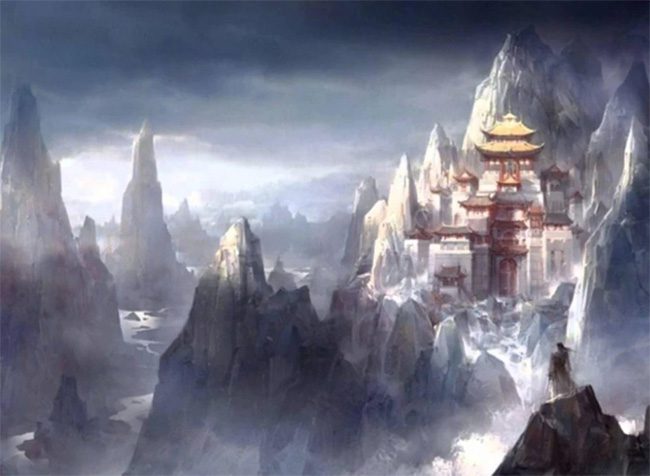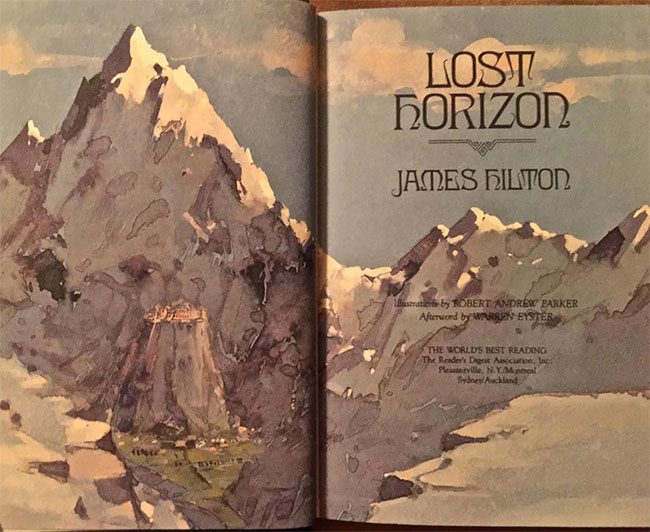The legend of a mystical land called Shangri-La has long captivated explorers, yet no one has ever set foot there. Could this be the gateway to a true “paradise”?
Where is “Paradise”?
Many different mythological stories revolve around “paradise on Earth”, but the name originates from the novel Lost Horizon by James Hilton, published in 1933.

The kingdom of Shambhala, or Shangri-La, is believed to be where the white crystal mountains are.
In this work, the author renamed a paradise in Tibet, Shambhala, to Shangri-La. The name and concept of Shangri-La have become so famous that today it is associated with a lost paradise or a fairyland that many are still striving to find.
What Hilton describes is not entirely his imagination, as the details were borrowed from ancient Tibetan mythologies about Shambhala. But what is the reality behind these legends, and how can one reach this paradise on Earth? Where is its actual location?
Some believe it is the modern city of Shangri-La in China, although this name has only existed since 2001. Others insist that this “paradise” is the Hunza Valley in Pakistan.
They believe that Hilton briefly stayed in this beautiful oasis and drew upon the scenery here to describe details in his work. However, many argue that Hunza could only be an inspiration for the novelist, not the “paradise on Earth.”
According to legend, the Shangri-La Valley or “Shambhala kingdom” originates from Tibet, a sacred site of South Asian culture and spirituality. It is believed that the most accurate location of Shangri-La is near the India-Tibet border, in the Arunachal Pradesh region.
Hidden among the majestic Himalayas and protected by lofty peaks, this land is extremely significant to the spirituality of India and Tibet. It is no surprise that Hilton chose such a picturesque landscape as the backdrop for his famous novel.
The Kingdom of Peace and Wisdom
The ancient mythology of Shambhala has its earliest forms recorded in India around 962 AD. The origin of this story comes from a Buddhist text that has been passed down and preserved in Tibet.
The tale tells of a high land behind the majestic Himalayas, blessed with peace and harmony. The inhabitants here live separately from the outside world and are indifferent to worldly possessions. They hold the ancient secret key to longevity and the purest Buddhist teachings on peace.
It is said that the monks and people here await the day when the world, weary of violence, is ready to live in peace. Only then will the monks reveal the location of “paradise” and their true identity.
Mythology also states that this “paradise” is ruled by a lineage of enlightened “kings” who wait for the evils and violence in the world to reach their peak. At that time, they will appear with a mighty army to vanquish anyone who delights in war and greed.
Regardless, the legend of the Himalayas conceals a secret paradise, isolated and safe from the outside world, which many believe in. This mysterious place is thought to be the source of all knowledge, wisdom, and enlightened peace in the world.
Even the name Shambhala comes from Sanskrit, meaning ‘the place.’ Inspired by this, many Western travelers have sought the true location of Shangri-La or Shambhala, hoping to uncover the true meaning of peace and knowledge.
How to Find Shangri-La?

The famous work about Shangri-La by author James Hilton.
The first efforts to search for Shangri-La may have come in the late 1500s or early 1600s, when Western guests arrived at the court of Emperor Akbar of the Mughal Empire to hear tales of a mystical paradise beyond the Himalayas.
Many believe that the kingdom of Shambhala thrives under the shadow of a white crystal mountain, where a grand palace stands beside a crystal-clear lake.
In this palace, many wise monks assist the king in safeguarding the sanctity of wisdom and peace in the world. Many travelers from ancient to medieval times have attempted to reach the mystical land of Shambhala, but to no avail.
From then on, it is believed that this place can only be found by those with pure hearts and clear minds. Only when a person follows the spiritual path, shedding all material possessions and desires, can they find Shangri-La.
The first king of Shambhala is said to have met the Buddha and was taught about Kalachakra or “the Wheel of Time.” The teachings and higher understandings related to the “Wheel of Time” were then entrusted to the king for protection.
Many believe that the mythical Shangri-La still holds the teachings of the “Wheel of Time,” safeguarding texts containing secrets against malevolent forces from the outside. This gives rise to the hypothesis that Shangri-La could be a place in another world inhabited by supernatural beings different from ordinary humans.
An enlightened person must use their mind’s eye to find Shambhala in its true form. As very few can undertake such a challenging journey today, Shangri-La remains shrouded in mystery. Does it truly exist? Perhaps! But whether we can access it, according to religious historians, depends on ourselves.





















































